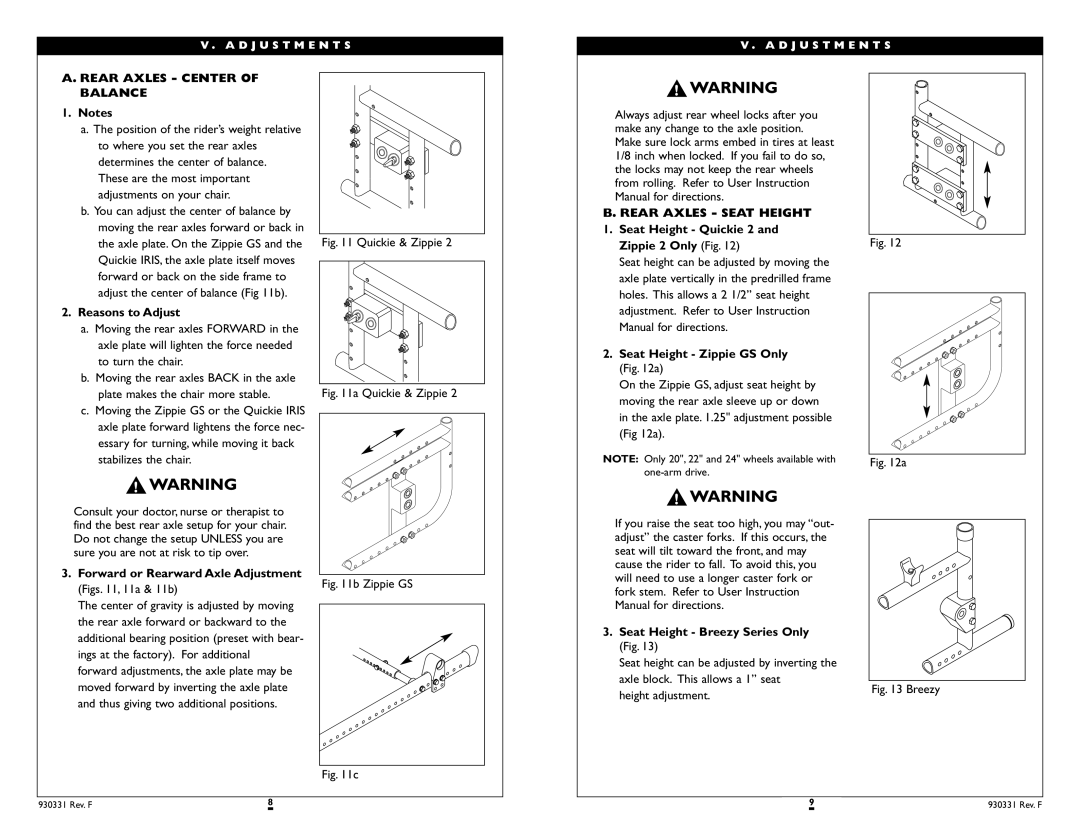
V . A D J U S T M E N T S
V . A D J U S T M E N T S
A. REAR AXLES - CENTER OF BALANCE
1.Notes
a.The position of the rider’s weight relative to where you set the rear axles determines the center of balance. These are the most important adjustments on your chair.
b.You can adjust the center of balance by moving the rear axles forward or back in the axle plate. On the Zippie GS and the Quickie IRIS, the axle plate itself moves forward or back on the side frame to adjust the center of balance (Fig 11b).
2.Reasons to Adjust
a.Moving the rear axles FORWARD in the axle plate will lighten the force needed to turn the chair.
b.Moving the rear axles BACK in the axle plate makes the chair more stable.
c.Moving the Zippie GS or the Quickie IRIS axle plate forward lightens the force nec- essary for turning, while moving it back stabilizes the chair.
Consult your doctor, nurse or therapist to find the best rear axle setup for your chair. Do not change the setup UNLESS you are sure you are not at risk to tip over.
3.Forward or Rearward Axle Adjustment (Figs. 11, 11a & 11b)
The center of gravity is adjusted by moving the rear axle forward or backward to the additional bearing position (preset with bear- ings at the factory). For additional forward adjustments, the axle plate may be moved forward by inverting the axle plate and thus giving two additional positions.
Fig. 11 Quickie & Zippie 2
Fig. 11a Quickie & Zippie 2
Fig. 11b Zippie GS
Always adjust rear wheel locks after you make any change to the axle position. Make sure lock arms embed in tires at least 1/8 inch when locked. If you fail to do so, the locks may not keep the rear wheels from rolling. Refer to User Instruction Manual for directions.
B. REAR AXLES - SEAT HEIGHT
1.Seat Height - Quickie 2 and Zippie 2 Only (Fig. 12)
Seat height can be adjusted by moving the axle plate vertically in the predrilled frame holes. This allows a 2 1/2” seat height adjustment. Refer to User Instruction Manual for directions.
2.Seat Height - Zippie GS Only (Fig. 12a)
On the Zippie GS, adjust seat height by moving the rear axle sleeve up or down in the axle plate. 1.25" adjustment possible (Fig 12a).
NOTE: Only 20", 22" and 24" wheels available with
If you raise the seat too high, you may “out- adjust” the caster forks. If this occurs, the seat will tilt toward the front, and may cause the rider to fall. To avoid this, you will need to use a longer caster fork or fork stem. Refer to User Instruction Manual for directions.
3.Seat Height - Breezy Series Only (Fig. 13)
Seat height can be adjusted by inverting the axle block. This allows a 1” seat
height adjustment.
Fig. 12
Fig. 12a
Fig. 13 Breezy
Fig. 11c
930331 Rev. F | 8 | 9 | 930331 Rev. F |
|
|
|
|
